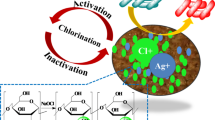Abstract
In this study, chitosan and pentasodium tripolyphosphate (TPP)-based bilayers were fabricated on the cationized woven cotton fabrics via layer-by-layer (LBL) self-assembly technique. The initial cationic charges on cotton fabric were produced through the aminization procedure involving the covalent attachment of reactive dye to cotton fabric and subsequent reductive cleavage of the dye to free amine. Different numbers of bilayers (1, 5, and 10) consisting of chitosan/TPP have been deposited on the fabrics. The surface morphology, cationic group content, chemical surface modification, whiteness index, surface tension and antibacterial properties of the modified cotton samples were investigated using scanning electron microscopy (SEM), methylene blue test, FTIR, reflectance spectroscopy, water contact angle measurements and antibacterial test, respectively. The bacterial inhibition experiments demonstrated that the modified cotton fabric with the addition of chitosan/TPP bilayers can increase the degree of inhibition on E. coli and S. aureus bacteria. The utilized LBL method was an easy and cost-effective procedure for develo** of novel antibacterial textiles with the highly attractive feature in the medical and hygienic products.
Similar content being viewed by others
References
P. J. Brown and K. Stevens, “Nanofibers and Nanotechnology in Textiles”, Woodhead Publishing, 2007.
M. L. Gulrajani and G. Deepti, Ind. J. Fibre Text., 36, 10 (2011).
A. Bashari, N. Hemmatinejad, and A. Pourjavadi, Polym. Adv. Technol., 24, 797 (2013).
S. Uğur, M. Sariişik, A. H. Aktaş, M. Ç. Uçar, and E. Erden, Nanoscale Res. Lett., 5, 1204 (2010).
R. Ou, J. Zhang, Y. Deng, and A. J. Ragauskas, J. Appl. Polym. Sci., 105, 1987 (2007).
G. Decher, Science, 277, 1232 (1997).
G. Wu and X. Zhang in “Polymer Thin Films” (A. A. Hashim Ed.), In-Teh Publishing, 2010.
A. Tourrette, M. M. C. G. Warmoeskerken, and D. Jocic, “Layer-By-Layer Deposition of Poly(N-Isopropylacrylamide)/Chitosan Microgels over Cotton Fabric”, İzmir, Turkey, 2009.
A. P. Gomes, J. F. Mano, J. A. Queiroz, and I. C. Gouveia, Polym. Adv. Technol., 24, 1005 (2013).
S. T. Dubas, P. Kumlangdudsana, and P. Potiyaraj, Colloid. Surface A, 289, 105 (2006).
M. Joshi, R. Khanna, R. Shekhar, and K. Jha, J. Appl. Polym. Sci., 119, 2793 (2011).
J. Alongi, F. Carosio, and G. Malucelli, Polym. Degrad. Stabil., 97, 1644 (2012).
H. Deng, X. Zhou, X. Wang, C. Zhang, B. Ding, Q. Zhang, and Y. Du, Carbohyd. Polym., 80, 474 (2010).
H. Deng, X. Wang, P. Liu, B. Ding, Y. Du, G. Li, X. Hu, and J. Yang, Carbohyd. Polym., 83, 239 (2011).
W. Huang, H. Xu, Y. Xue, R. Huang, H. Deng, and S. Pan, Food Res. Int., 48, 784 (2012).
D. Jocic, A. Tourrette, P. Glampedaki, and M. M. C. G. Warmoeskerken, Mater. Technol.: Adv. Perf. Mate., 24, 14 (2009).
X. Zhang, H. Chen, and H. Zhang, Chem. Commun., 14, 1395 (2007).
S. Y. Kim, A. Zille, M. Murkovic, G. Güebitz, and A. Cavaco-Paulo, Enzyme Microb. Tech., 40, 1782 (2007).
C. T. A. E. C. Ibezim, C. M. B. Barretto, D. C. Odimegwu, and F. F. D. Lima, Ibnosina J. Med. Biol. Sci., 3, 10 (2011).
J. W. Ostrander, A. A. Mamedov, and N. A. Kotov, J. Am. Chem. Soc., 123, 1101 (2001).
P. Bonina, T. Petrova, and N. Manolova, J. Bioact. Compat. Pol., 19, 101 (2004).
B. Gottenbos, D. W. Grijpma, H. C. van der Mei, J. Feijen, and H. J. Busscher, J. Antimicrob. Chemoth., 48, 7 (2001).
P. Dezelee and E. Bricas, Biochemistry, 9, 823 (1970).
Author information
Authors and Affiliations
Corresponding authors
Rights and permissions
About this article
Cite this article
Shirvan, A.R., Nejad, N.H. & Bashari, A. Antibacterial finishing of cotton fabric via the chitosan/TPP self-assembled nano layers. Fibers Polym 15, 1908–1914 (2014). https://doi.org/10.1007/s12221-014-1908-y
Received:
Revised:
Accepted:
Published:
Issue Date:
DOI: https://doi.org/10.1007/s12221-014-1908-y



